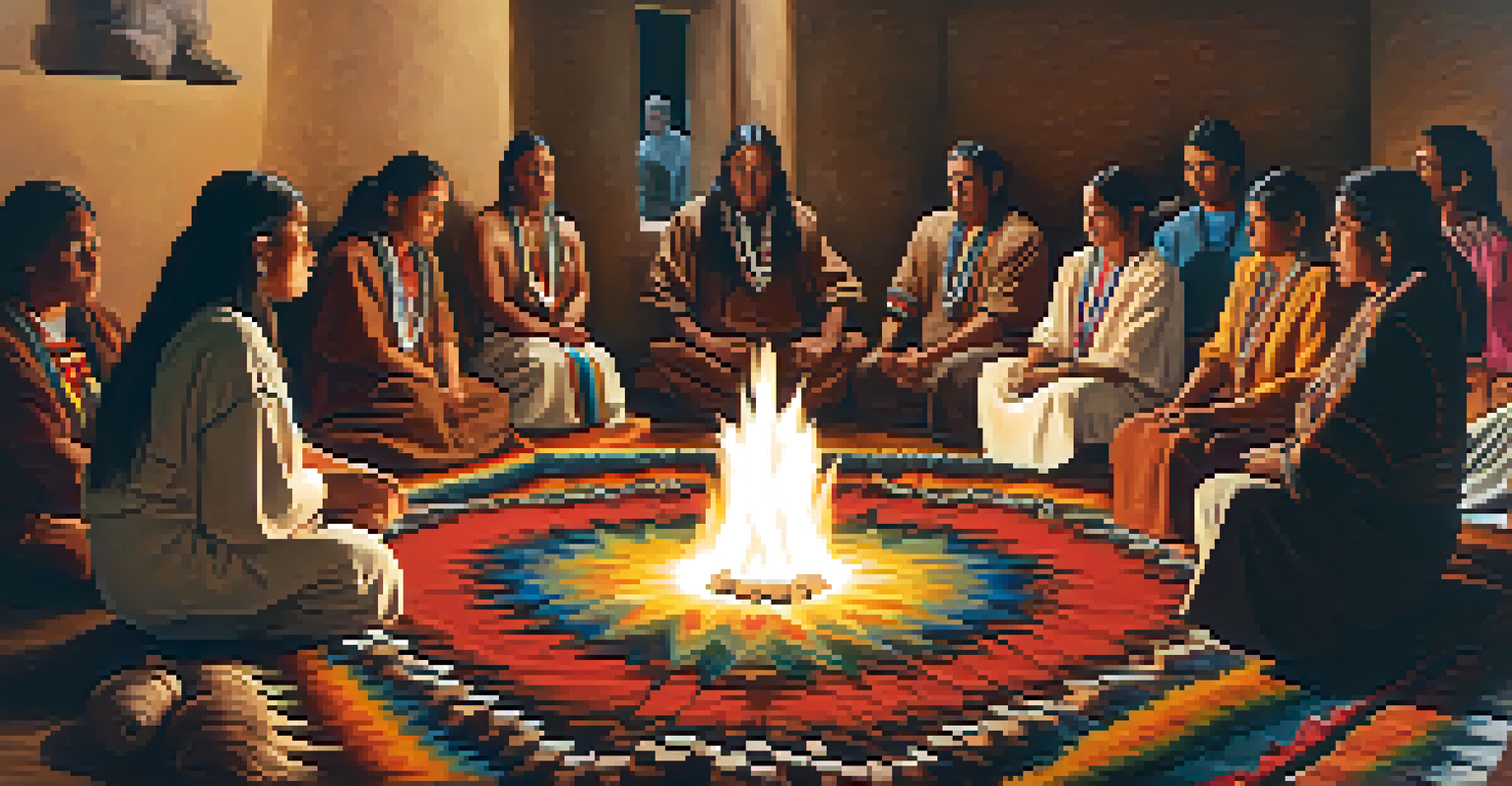The Sacred Cactus: Peyote in Native American Traditions

Understanding Peyote: A Brief Overview
Peyote, a small cactus native to Mexico and the southwestern United States, holds significant cultural importance in many Native American traditions. Known scientifically as Lophophora williamsii, this cactus contains psychoactive compounds, particularly mescaline, which induce altered states of consciousness. These properties have made peyote a central element in various spiritual practices, particularly among the Huichol and Navajo tribes.
The plant’s growth, with its vibrant flowers and hardy resilience, reminds users of the cycles of life and the importance of living in harmony with the earth.
The use of peyote dates back thousands of years, intertwining with the rituals and belief systems of Native peoples. For many, it is not just a plant but a revered teacher that provides insights and connects users to the spiritual realm. The experience is often seen as a journey rather than mere consumption, emphasizing the deep respect for nature and its gifts.
In recognizing peyote's significance, it becomes essential to approach its use with respect and understanding. It is not merely a recreational substance; for many, it is a bridge to the divine and a tool for healing. This distinction highlights the need to honor the traditions surrounding its use.
Historical Context of Peyote Use
Peyote's use can be traced back to ancient civilizations in Mesoamerica, where it played a role in religious ceremonies. Archaeological evidence suggests that peyote has been utilized for over 5,000 years, showcasing its enduring importance in cultural practices. As these traditions evolved, peyote became integrated into the spiritual lives of various Native American tribes.

The arrival of European settlers marked a significant shift in the relationship between indigenous peoples and peyote. While some settlers viewed it with suspicion, others recognized its role in Native traditions. This complex interaction led to both resistance and adaptation, with peyote continuing to be a vital part of spiritual practices despite external pressures.
Peyote's Cultural Significance
Peyote serves as a sacred gift in Native American traditions, offering spiritual insights and fostering a deep connection with the Creator.
In the late 19th and early 20th centuries, the establishment of the Native American Church symbolized a formalization of peyote use within a religious context. This movement sought to preserve indigenous practices while encouraging a sense of unity among tribes. The church’s formation was a pivotal moment, allowing for the continuation of peyote rituals amidst changing societal attitudes.
Peyote in Ritual and Ceremony
Peyote ceremonies are deeply meaningful events that vary among tribes but share common elements of prayer, singing, and communal sharing. These ceremonies often last several hours, with participants consuming peyote to enter a meditative state. The experience is guided by a leader, known as a roadman, who facilitates the ceremony, ensuring that it aligns with spiritual principles.
Engaging with peyote requires understanding and respect for its cultural significance, as well as recognition of the ongoing challenges faced by Native communities.
During these gatherings, participants seek personal visions, healing, and a deeper connection to their ancestors and the universe. The communal aspect fosters a sense of belonging and support, reinforcing the bonds within the community. Attendees often feel a collective energy, which is believed to enhance the spiritual experience.
Moreover, these rituals are not just about the individual; they also serve to reinforce cultural identity and values. By participating in peyote ceremonies, individuals affirm their connection to their heritage and the teachings of their forebears. This layered significance makes peyote a potent symbol of resilience and spirituality.
The Spiritual Significance of Peyote
For many Native Americans, peyote is viewed as a sacred gift from the Creator, embodying a profound spiritual significance. It is often described as a means to communicate with the spirit world, providing guidance and wisdom to those who seek it. This belief underscores the deep respect and reverence that surround its use.
The visions induced by peyote are interpreted as messages from the divine, offering insights into personal struggles and broader existential questions. Participants often emerge from ceremonies with a renewed sense of purpose and clarity, reflecting the transformative power of these experiences. This spiritual journey is deeply personal, yet it resonates within the larger context of community and tradition.
Challenges to Peyote's Survival
Overharvesting, habitat destruction, and legal restrictions pose significant threats to the sustainability of peyote and its use in spiritual practices.
Additionally, peyote symbolizes the interconnection between nature and spirituality. The plant’s growth, with its vibrant flowers and hardy resilience, reminds users of the cycles of life and the importance of living in harmony with the earth. This relationship with nature is central to many Native American philosophies, emphasizing sustainability and respect for the environment.
Contemporary Challenges Facing Peyote Use
Despite its deep-rooted significance, the use of peyote faces numerous challenges in contemporary society. Factors such as overharvesting and habitat destruction threaten the cactus's survival, raising concerns among Native communities about the sustainability of their sacred plant. As demand grows, the delicate balance between preserving peyote and meeting spiritual needs becomes increasingly precarious.
Legal issues also complicate the landscape of peyote use. While some states allow its use for religious purposes, others impose strict regulations that can hinder access for those who rely on it for spiritual practices. This patchwork of laws often leads to confusion and frustration for Native American practitioners seeking to uphold their traditions.
Moreover, cultural appropriation poses a significant threat, as non-Native individuals sometimes engage with peyote outside its traditional context. This can dilute its sacredness and undermine the very cultural practices that have preserved it for centuries. It highlights the importance of education and respect for indigenous traditions in navigating these complex dynamics.
Peyote and the Future of Native Traditions
As we look to the future, the role of peyote within Native American traditions continues to evolve. Younger generations are increasingly engaging with their cultural heritage, often revitalizing traditional practices like peyote ceremonies. This resurgence speaks to a broader movement of cultural reclamation, as indigenous peoples seek to reclaim their narratives and spiritual practices.
Furthermore, the contemporary discourse around mental health and well-being has opened new avenues for understanding the therapeutic benefits of peyote. Some advocates argue that controlled use of peyote could help address issues like depression and anxiety, providing a bridge between ancient wisdom and modern science. This intersection could foster greater awareness and respect for indigenous practices in wider society.
Revival of Traditional Practices
Younger generations are revitalizing peyote ceremonies, highlighting a movement of cultural reclamation and the intersection of ancient wisdom with modern mental health discussions.
Ultimately, the future of peyote and its traditions will depend on a collective effort to preserve, respect, and understand its significance. Engaging in open dialogue and education can help ensure that peyote remains a sacred and integral part of Native American spirituality for generations to come.
Conclusion: Embracing the Sacredness of Peyote
In conclusion, peyote represents more than just a cactus; it symbolizes a deep spiritual connection, cultural resilience, and the ongoing struggle to maintain indigenous traditions. Its importance in Native American ceremonies reflects a profound respect for nature and the wisdom that comes from it. As we navigate the complexities surrounding peyote in modern society, it is crucial to honor its sacredness and the traditions that surround it.
Engaging with peyote requires understanding and respect for its cultural significance, as well as recognition of the ongoing challenges faced by Native communities. By fostering awareness and appreciation for these practices, we can support the preservation of rich cultural legacies that have endured for centuries. This commitment to honoring tradition is essential in a world that often overlooks the wisdom of indigenous peoples.

Ultimately, embracing the sacredness of peyote invites us to reflect on our relationship with nature, spirituality, and community. By learning from these traditions, we can foster a more compassionate and inclusive society that values diverse perspectives and honors the teachings of the past.